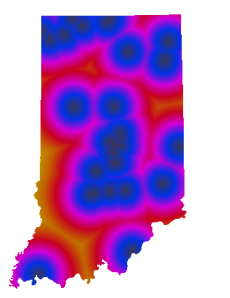How far away are you from beer on a Sunday in Indiana?
Answer: At most 50 miles.
Inspired by GIS blogger Darren Cope’s analysis of Tim Horton’s locations in Canada I decided to figure out how far you are at any given time from a microbrewery in Indiana. Instead of Canadian coffee and donuts I mapped brewery locations. I pulled the Brewer’s Guild of Indiana’s membership list (and took out Bee Creek, I’m pretty sure they’re closed). This is a vital map because Indiana’s blue laws prohibit alcohol sales on Sundays except at microbreweries and vineyards. Two things I don’t like on Sundays, wine and crossing state boundaries so this was a vital project for me. I found that I really don’t want to be in northeast Dubois County on a Sunday. Seriously, 50 miles. Dang. At least people in Vincennes and Terre Haute can jump over to Illinois for a 6 pack.
I followed Cope’s steps except to get the lat / long for the breweries I had to geocode them against the TIGER street centerlines and instead of using GRASS directly I used QGIS’s GRASS plugin. This article was a big help on getting a GRASS workspace set up to create the raster.
